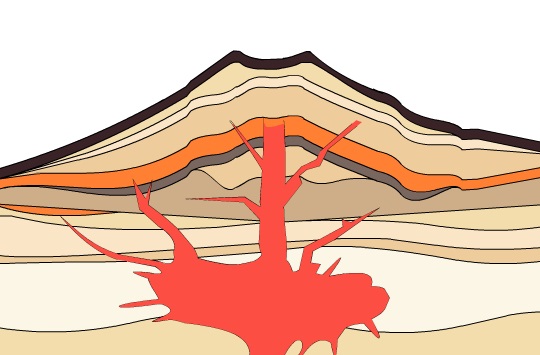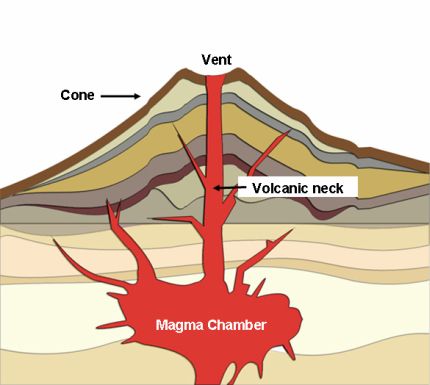Molten rock at the Earth's surface is called Lava, if it is underground it is called Magma.
Magma is less dense than the surrounding rock under the Earth's surface so it rises up to the surface through cracks and crevices under the Earth. Magma contains high amounts of dissolved gases that are trapped within the magma and as magma approaches the surface the gas bubbles out and is released.

The silica content of the magma determines how thick the magma is and how easily it flows through the cracks and crevices below the surface. The silica content also determines how easily dissolved gases can escape from the magma. Low silica content results in a very fluid magma that moves relatively easily underground and allows gas within the magma to easily escape (think carbonated soda). High silica content results in a viscous magma that does not move easily underground and does not allow trapped gases to escape (think cold maple syrup).
The diagram below illustrates a volcanic cone and the parts of a volcano.

Cone: This is a cone shaped relief feature built by volcanic material. It varies in height from small to very large.
Vent: The hole at the top of the volcano. Lava is extruded from the vent.
Caldera: This is the collapsed crater that forms when lava withdraws into magma chamber or from an explosive eruption.
The volcanic eruption that results from magma moving to the surface varies greatly depending on the composition of the magma.
Volcanic eruptions with low silica magma are characterized by "quiet" eruptions. Magma is able to easily flow out of the ground. These eruptions produce lots of lava, but very little, if any, ash. Gas readily escapes from the lava.
Volcanic eruptions with high silica magma are characterized by explosive eruptions. Magma cannot easily flow through the cracks and crevices under the surface and out of the ground. Pressure builds under the ground until the pressure exerted by the upwelling magma and gas is greater than the pressure of the overlying rock units. The magma erupts out of the ground explosively. Explosive eruptions are characterized by little lava and lots of ash. Pyroclastic flows and lahars, which will be discussed shortly, often result from explosive eruptions.